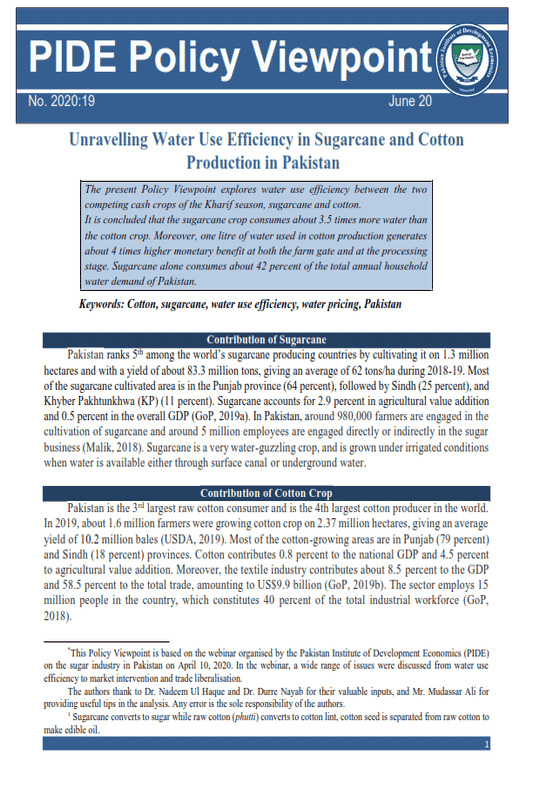
Pakistan Institute of Development Economics
- Home
Our Portals
MenuMenuMenuMenuMenuMenuMenu - ResearchMenuMenuMenuMenuMenuMenuMenu
- Discourse
- The PDR
- Our Researchers
- Academics
- Degree Verification
- Thesis Portal
- Our Portals
Unravelling Water Use Efficiency In Sugarcane And Cotton Production In Pakistan (PIDE Policy Viewpoint 19:2020)
The Present Policy Viewpoint Explores Water Use Efficiency Between The Two Competing Cash Crops Of The Kharif Season, Sugarcane And Cotton. It Is Concluded That The Sugarcane Crop Consumes About 3.5 Times More Water Than The Cotton Crop. Moreover, One Litre Of Water Used In Cotton Production Generates About 4 Times Higher Monetary Benefit At Both The Farm Gate And At The Processing Stage. Sugarcane Alone Consumes About 42 Percent Of The Total Annual Household Water Demand Of Pakistan.
Contribution of Sugarcane
Pakistan ranks 5th among the world’s sugarcane producing countries by cultivating it on 1.3 million hectares and with a yield of about 83.3 million tons, giving an average of 62 tons/ha during 2018-19. Most of the sugarcane cultivated area is in the Punjab province (64 percent), followed by Sindh (25 percent), and Khyber Pakhtunkhwa (KP) (11 percent). Sugarcane accounts for 2.9 percent in agricultural value addition and 0.5 percent in the overall GDP (GoP, 2019a). In Pakistan, around 980,000 farmers are engaged in the cultivation of sugarcane and around 5 million employees are engaged directly or indirectly in the sugar business (Malik, 2018). Sugarcane is a very water-guzzling crop, and is grown under irrigated conditions when water is available either through surface canal or underground water.
Contribution of Cotton Crop
Pakistan is the 3rd largest raw cotton consumer and is the 4th largest cotton producer in the world. In 2019, about 1.6 million farmers were growing cotton crop on 2.37 million hectares, giving an average yield of 10.2 million bales (USDA, 2019). Most of the cotton-growing areas are in Punjab (79 percent) and Sindh (18 percent) provinces. Cotton contributes 0.8 percent to the national GDP and 4.5 percent to agricultural value addition. Moreover, the textile industry contributes about 8.5 percent to the GDP and 58.5 percent to the total trade, amounting to US$9.9 billion (GoP, 2019b). The sector employs 15 million people in the country, which constitutes 40 percent of the total industrial workforce (GoP, 2018).
_________
*This Policy Viewpoint is based on the webinar organised by the Pakistan Institute of Development Economics (PIDE) on the sugar industry in Pakistan on April 10, 2020. In the webinar, a wide range of issues were discussed from water use efficiency to market intervention and trade liberalisation.
The authors thank to Dr. Nadeem Ul Haque and Dr. Durre Nayab for their valuable inputs, and Mr. Mudassar Ali for providing useful tips in the analysis. Any error is the sole responsibility of the authors.
1 Sugarcane converts to sugar while raw cotton (phutti) converts to cotton lint, cotton seed is separated from raw cotton to make edible oil.
_________
Pakistan Sugar Mills Association’s Perspective
According to the evidence presented by the representative of the Pakistan Sugar Mills Association (Khan, 2020), sugar requires 1500-2000 litres of water per kg, while lint cotton requires 10,000 litres of water per kg. This comparison relates to the second stage of the value chain i.e. after completing the first stage of processing2. Based on Verma (2016), it is further added that per month water requirement is the same (150 mm) for both sugarcane and cotton crop at the farm gate stage. Based on these statistics, one may conclude that sugarcane is more water-efficient than cotton. But cotton crop takes only 4 to 5 months from planting to harvest while sugarcane takes 11 months, implying that longer crop duration of sugarcane makes its total water demand more than double to that of cotton. Despite the difference in the crop duration, per month water requirement of sugarcane and seed cotton (phutti) is 182 and 167 mm, respectively (Bhaskar, 2019). Our estimate also supports the existing literature that per month water requirement of sugarcane (208mm/month) is significantly higher than cotton (147mm/month). Hence, the conclusion that sugarcane is a more water-efficient crop is misleading.
The average yield of cotton and sugarcane are 286 kg/acre and 24,668 kg/acre, respectively (GoP, 2019b). We converted lint cotton to seed cotton by using the conversion factor of 0.43 (CIRAD, 2009). By using the concept of per kg water requirement for each crop, the current Policy Viewpoint estimates per acreage water requirement for both cotton and sugarcane, as presented in Table 1. We then estimate the water use ratio by dividing the water requirement of sugarcane per acre with the water requirement of cotton per acre, also presented in Table 1. The estimated water use ratio (3.4.) reveals that relieving one acre from sugarcane can provide water to about 3.5 acres of the cotton crop.



